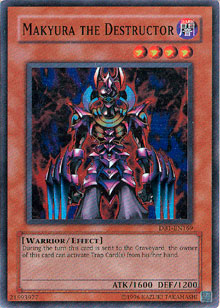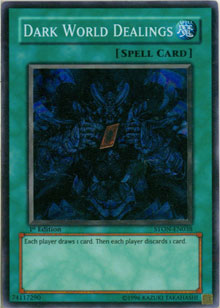Today we’ll be looking at the extraordinarily undervalued Makyura the Destructor, a card that hit the Forbidden list almost immediately after it was released. Normally, the Forgotten Format articles use the Traditional format to highlight Advanced decks: however, this week will be entirely focused on the Traditional format. This deck is just too fun to pass up, so we’ll be throwing inhibitions to the wind and indulging in a purely one-format idea: a first-turn KO with Makyura and Exodia. However, if you’re a strictly Advanced format player, instead of following the concept of the actual deck, consider the thought process taken in constructing it. Use mathematics in your deck construction: it will help you go into a match with a strong edge.
There isn’t any fooling around with this deck—you’ll be trying to draw every card in your deck on the first turn. If you take a second turn, the deck failed. This deck is particularly fun, because there are very few ways for your opponent to stop you. If your local tournament holds Traditional competitions, this is something worth trying.

The Monster Lineup
We end the monster lineup with three copies of Thunder Dragon. This serves two functions: it allows us to thin the deck, and it allows us another card in hand, to be discarded for card-drawing power. By playing three copies of Thunder Dragon, we are in effect running two fewer cards than normal. That brings our total cards in deck down to 38.

The Spells
Happily, we are able to find cards that fit both groups. Hand Destruction and Dark World Dealings can send Makyura to the graveyard while drawing more cards. Synergy is always a good friend to have on your side! The spell lineup ends with the three copies of Toon Table of Contents, which brings our total card count down another two cards, to 36.
The Traps
The trap lineup is simple, and allows for three more cards similar to Pot of Greed (the three copies of Reckless Greed, and six more cards similar to Upstart Goblin).
This means that the deck operates on two levels: before it sends Makyura to the graveyard, and after it does so. We’ll have to do the math for each separately.
We already know that we’ll be doing this math out of only 36 cards, because of the three copies of both Thunder Dragon and Toon Table of Contents. However, we also have to thin the deck by another three cards for Upstart Goblin, another one (arguably more) for both Pot of Greed and Graceful Charity, and one for all copies of Hand Destruction and Dark World Dealings. Before we send Makyura to the graveyard, that’s really the only thing we focus on. We’ll be looking to draw either Painful Choice or Reinforcement of the Army in conjunction without discarding cards, or a copy of Foolish Burial.
With the above changes to our total deck count made, we are (in a sense) only running 25 cards. There are two ways for us to send Makyura to the graveyard: getting him in our hand and discarding him, or sending him directly to the graveyard.
To get him in our hand, we’ll either have to draw him, a Reinforcement of the Army card, or a Painful Choice card. That’s a total of four cards. That chance is 0.16. Then we’ll have to discard him, which we can do with seven cards. The chance of that is 0.28. That brings the chances of pulling this off to a total of about five percent.
We can also simply draw Premature Burial, which is two cards out of the 25, yielding an eight percent chance of doing so. That gives every card a thirteen percent chance of sending Makyura to the graveyard: we start with six. That means our starting hand has, on average, a 78 percent chance of sending Makyura to the graveyard. Those are some incredible odds!
After that, we simply ride out the drawing power of the deck until we draw all five pieces of Exodia. That should happen almost every time, so we can reasonably assume at least a 0.70 win consistency before our opponent even draws a card! That’s a phenomenal number for a first-turn KO deck, because it isn’t dependant on our opponents’ actions. To lose, you’ll have to hit that 0.30 pocket twice in a match, which is only about a fifteen percent chance! You’ll be winning roughly 85 percent of your matches.
Hopefully the mathematic principles stated here can make you consider the development of your deck archetypes. These concepts can (and should) be used when making decks. Good luck, and have fun applying math to your game play!
—Ryan Murphy